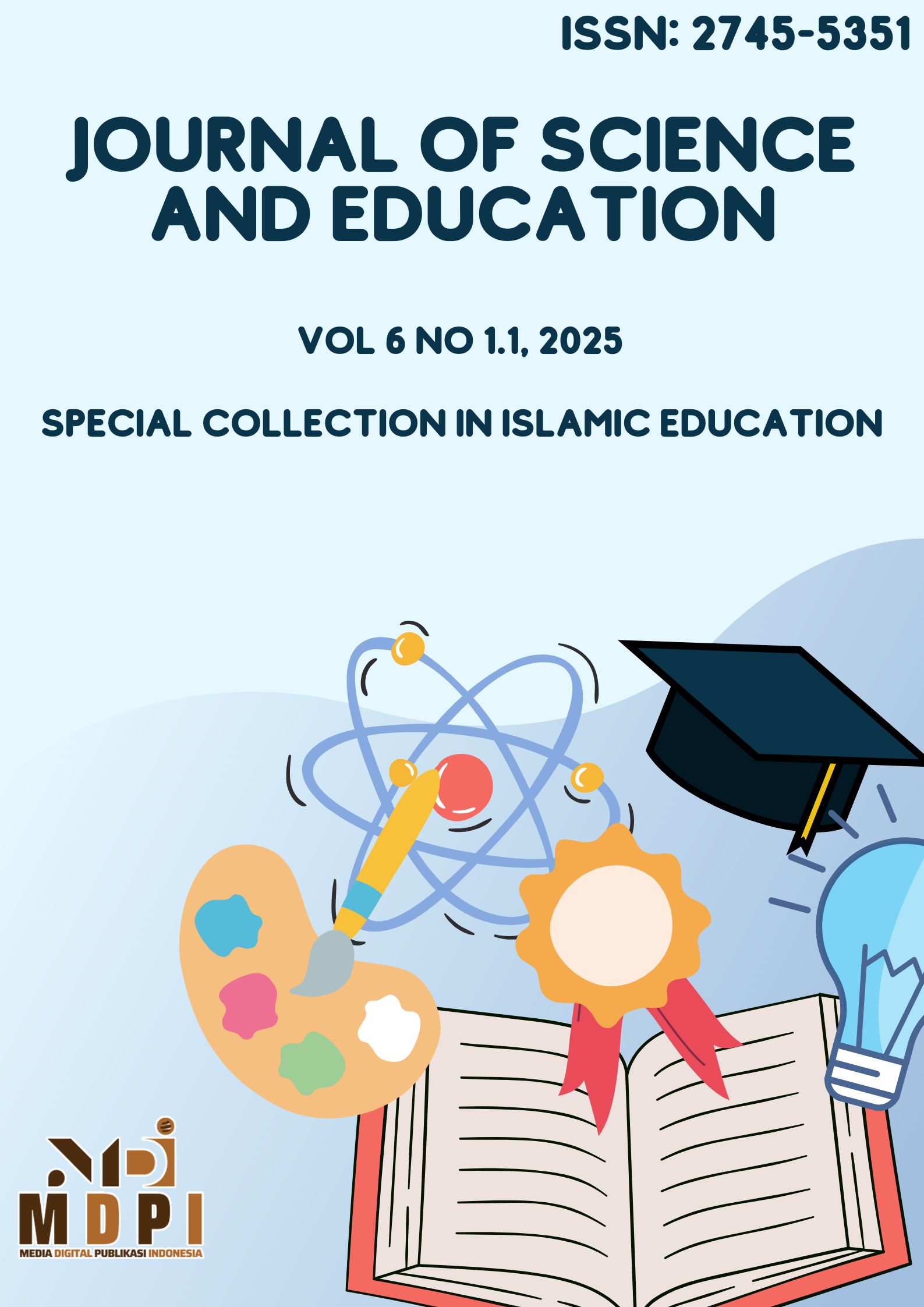Islamic Education in the Digital Era: Pedagogical Competence, Technology Acceptance, and Managerial Supervision
DOI:
https://doi.org/10.58905/jse.v6i1.1.642Keywords:
Islamic education, digital transformation, TPACK, TAMISE, MTDPIAbstract
The rapid advancement of digital technology in the 21st century has significantly influenced the landscape of education, including Islamic Religious Education (PAI). Teachers are expected not only to master basic knowledge but also to integrate critical thinking, creativity, and adaptability into their instructional practices. This study aims to analyze the implementation of digital transformation in Islamic education through the lens of pedagogical competence, managerial supervision, and cultural adaptation. A qualitative approach with a case study design was employed, focusing on purposively selected institutions that demonstrate initiatives in digital Islamic learning. Data were collected through literature review, document analysis, and triangulation with empirical findings from recent studies. The researcher acted as the primary instrument, supported by systematic coding and thematic matrices, while trustworthiness was ensured using credibility, transferability, dependability, and confirmability criteria. Data were analyzed using the interactive model of Miles, Huberman, and Saldaña. The findings reveal that the integration of the TPACK (Technological Pedagogical Content Knowledge) and TAMISE (Technology Acceptance Model in Islamic Education) frameworks significantly improved the effectiveness of PAI learning. Student engagement increased by 41% through augmented reality and gamification, while 89% of teachers successfully developed adaptive learning modules using AI-based tools. The MTDPI (Model Transformasi Digital Pendidikan Islam), which incorporates a maqāṣid shariah-based technocultural foundation, hybrid pedagogy, and a scholar-technocrat ecosystem, proved effective in aligning innovation with Islamic values. However, implementation challenges persist. Only 29% of madrasahs in rural areas have adequate internet access compared to 89% in urban areas, highlighting infrastructural inequality. Moreover, 34% of senior teachers resisted the use of gamification, citing concerns over the sacredness of Islamic knowledge. Governance issues, particularly the absence of content verification mechanisms, were also identified as barriers. Nonetheless, blockchain-based evaluation systems demonstrated potential by reducing verification time from seven days to two hours while ensuring content authenticity.
Downloads
References
I. Irwan, A. Arnadi, and A. Aslan, “Developing critical thinking skills of primary school students through independent curriculum learning,” Indones. J. Educ., vol. 4, no. 3, pp. 788–803, 2024.
J. C. Mugabekazi, J. Mukanziza, P. Nizeyimana, and P. Manirahari, “Integrating collaborative learning strategies in the curriculum: enhancing critical thinking and communication skills in primary education,” Eur. J. Educ. Stud., vol. 12, no. 3, 2025.
Y. Sudargini and A. Purwanto, “The effect of teachers pedagogic competency on the learning outcomes of students,” J. Ind. Eng. Manag. Res., vol. 1, no. 4, pp. 1–8, 2020.
M. Mujiyatun, N. Khodijah, and A. Abdurrahmansyah, “The Impact of Teachers’ Pedagogical and Professional Competence on Student Learning Outcomes,” Al-Ishlah J. Pendidik., vol. 13, no. 3, pp. 2865–2876, 2021.
M. Galton, “Change and continuity in the primary school: The research evidence,” Oxford Rev. Educ., vol. 13, no. 1, pp. 81–93, 1987.
L. Sugiar, S. Sukirman, and S. Sanusi, “Academic Supervision as a Strategy for Improving Teaching and Learning Quality,” Int. J. Educ. Adm. Manag. Leadersh., pp. 31–48, 2024.
S. Saihu, “The urgency of total quality management in academic supervision to improve the competency of teachers,” Edukasi Islam. J. Pendidik. Islam, vol. 9, no. 02, pp. 297–323, 2020.
A. L. Rodrigues, “Digital technologies integration in teacher education: the active teacher training model,” J. e-learning Knowl. Soc., vol. 16, no. 3, pp. 24–33, 2020.
J. R. Banas and C. S. York, “Authentic learning exercises as a means to influence preservice teachers’ technology integration self-efficacy and intentions to integrate technology,” Australas. J. Educ. Technol., vol. 30, no. 6, 2014.
B. B. Wiyono, A. Rasyad, and Maisyaroh, “The effect of collaborative supervision approaches and collegial supervision techniques on teacher intensity using performance-based learning,” Sage Open, vol. 11, no. 2, p. 21582440211013780, 2021.
M. Hanif, J. Widodo, J. Sutarto, and W. Wahyono, “Improving teacher capability through clinical supervision with the peer coaching grow me (PCGM) approach,” in Advances in Business, Management and Entrepreneurship, CRC Press, 2020, pp. 978–982.
R. Phumsaidorn and S. Julsuwan, “Supervision Model through Coaching and Mentoring for Enhancing Active Learning Instruction Competency of Elementary Teachers under Office of the Basic Education Commission.,” J. Educ. Learn., vol. 13, no. 5, pp. 34–47, 2024.
J. W. Cresswell, Research design : pendekatan metode kualitatif, kuantitatif, dan campuran edisi keempat, 4th ed. Yogyakarta: Pustaka Pelajar, 2019.
Adrias and A. Ruswandi, Desain Penelitian Kuantitatif, Kualitatif, dan Mix Method. Depok: Rajawali Pers, 2025.
M. Zed, Metode penelitian kepustakaan. Yayasan Pustaka Obor Indonesia, 2008.
M. N. Sari, N. Susmita, and A. Ikhlas, Melakukan Penelitian Kepustakaan. Pradina Pustaka, 2025.
M. Q. Patton, Qualitative research & evaluation methods: Integrating theory and practice. Sage publications, 2014.
A. Tashakkori and J. W. Creswell, “The new era of mixed methods,” J. Mix. Methods Res., vol. 1, no. 1, pp. 3–7, 2007, doi: 10.1177/2345678906293042.
Sugiyono, Metode Penelitian Kuantitatif, Kualitatif, dan R&D – MPKK, Cetakan 4. Bandung: Alfabeta, 2022.
E. J. Tisdell, S. B. Merriam, and H. L. Stuckey-Peyrot, Qualitative research: A guide to design and implementation. John Wiley & Sons, 2025.
Y. Lincoln and B. Guba, “Naturalistic inquiry. Beverly Hills: Sage Pulications.” Inc, 1985.
M. B. Miles, A. M. Huberman, and J. Saldaña, Qualitative Data Analysis: A Methods Sourcebook, Third edit. Thousand Oaks: SAGE Publications Inc, 2014.
A. K. Shenton, “Strategies for ensuring trustworthiness in qualitative research projects,” Educ. Inf., vol. 22, no. 2, pp. 63–75, 2004.
N. Hidayati and S. Choiriyah, “Application of the Technological Pedagogical and Content Knowledge (TPACK) Approach Based on Higher Order Thinking Skills (HOTS) in Islamic Religious Education Learning at the Madrasah Aliyah Level,” Al-Afkar, J. Islam. Stud., vol. 7, no. 3, pp. 139–152, 2024.
M. Ibrahim, S. Islam, O. Zohriah, and M. Azid, “Addressing contemporary ethical and moral issues through islamic education,” J. Islam. Stud., vol. 1, no. 1, pp. 36–51, 2024.
S. Juhairiah, D. Yuwono, and Q. Y. Kinasih, “Digital transformation in Islamic education: Opportunities, challenges, and its impact on Islamic values,” J. Vocat. Educ. Educ. Technol. Innov., vol. 1, no. 1, pp. 1–6, 2024.
Downloads
Published
How to Cite
Issue
Section
License
Copyright (c) 2025 Indra Azwar Mawardi, Ahmad Sukandar

This work is licensed under a Creative Commons Attribution-ShareAlike 4.0 International License.

















